The first of a fleet of new offshore patrol vessels, HMS Forth, has been revealed by BAE Systems and is ready to be launched in Glasgow.
The semi submersible barge ‘Dina Launcher’ was towed to the Clyde for the launch of HMS Forth, arriving earlier in the week.
The vessel will be moved onto the barge and then lowered into the River Clyde.
HMS Forth is a River class offshore patrol vessel under-construction on the Clyde. We’ve taken a closer look at her and the second vessel in the class, HMS Medway, as they near completion.
On the 6th of November 2013 it was announced that the Royal Navy had signed an Agreement in Principle to build three new OPVs based on the River class design at a fixed price of £348m including spares and support, an additional two vessels were outlined in the Strategic Defence & Security Review in 2015.
 During a Defence Select Committee in July 2016, the First Sea Lord Admiral Sir Philip Andrew Jones indicated that the option for a fleet of ‘up to six’ offshore patrol vessels had been reduced to five, with Clyde being replaced by one of the new Batch 2 ships.
During a Defence Select Committee in July 2016, the First Sea Lord Admiral Sir Philip Andrew Jones indicated that the option for a fleet of ‘up to six’ offshore patrol vessels had been reduced to five, with Clyde being replaced by one of the new Batch 2 ships.
Notice anything new outside our Govan facility in Glasgow? HMS FORTH revealed. pic.twitter.com/jtOB1ALA3o
— BAE Systems Maritime (@BAES_Maritime) August 15, 2016
From another angle!
HMS Forth now out of construction shed prior to launching this week
Photos: Gerard Wardhttps://t.co/kLNNVRQPNs pic.twitter.com/34ZvaXOBOg
— NavyLookout (@NavyLookout) August 15, 2016
HMS Forth will be submerged this week.
[su_custom_gallery source=”media: 6598,6597,6596,6594,6595,6593,6592″ limit=”30″ link=”lightbox” width=”120″ height=”120″ title=”never”]
The semi submersible barge ‘Dina Launcher’ is pictured here, ready to receive HMS Forth.

The First Sea Lord has elaborated on the potential uses for the Batch 2 ships overseas, including the possibility of forward basing an extra ship at the Falklands Islands, or forward basing it elsewhere. Admiral Sir Philip Jones said:
“Well, you are absolutely right that they have proved enormously useful, flexible and reliable ships. There are four vessels that we have in service at the moment. Three are Tyne, Mersey and Severn, which operate largely in UK waters on fishery protection and offshore tapestry protection, and of course they are increasingly working with the Border Force and the Maritime and Coastguard Agency in support of protection of UK waters. Then we have a fourth one, which is permanently based in the South Atlantic.
We have had those ships in service for quite some time now. We are looking at replacing them with slightly larger and more capable ships in due course anyway, so that was already in the course of production to bring three of those in. The additional two will enable us to take a longer term view of how we replace HMS Clyde, which is a slightly larger helicopter-capable version of the OPV. We are looking at a number of ways in which we might use the fifth one.
So, the fourth one is clearly a Clyde replacement.
The fifth one can either be added into the mix for the three that operate in UK waters or it could be forward-deployed somewhere else in the world, or it could become a second vessel operating in the South Atlantic. All those options are available.”
Pictured is ‘HMS Forth’ and one of her three sisters in an early stage of build.
[su_custom_gallery source=”media: 6089,6088,6087,6086,6085,6084,6083,6082″ limit=”30″ link=”lightbox” width=”120″ height=”120″ title=”never”]
Steel was cut on the 10th of October 2014 and they are expected to enter service starting 2017, with the last being delivered by the end of 2018.
The 90 metre OPV is based on a proven BAE Systems design which is already in service with the Brazilian Navy and Royal Thai Navy. BAE Systems have modified the design, ensuring it meets the requirements of the Royal Navy in support of UK interests both at home and abroad.
The programme has however been the focus widespread concern at the significantly increased cost of the Royal Navy variant.
The vessels will include a modified flight deck capable of operating Merlin helicopters, larger stores and more accommodation for embarked troops. They will also be the first ships to be built with a BAE Systems designed, new operating system called ‘Shared Infrastructure’, which will be rolled out across the Royal Navy surface fleet over the next ten years.
By replacing multiple large consoles dedicated to specific tasks with a single hardware solution, the amount of spares which are required to be carried on-board is reduced, significantly decreasing through-life costs.
The programme will sustain around 800 jobs on the Clyde and keep BAE yards ticking over over between work ending on new 70,600 tonne carrier HMS Prince of Wales and construction beginning on the first Type 26 frigates.
HMS Forth and her sisters will enter service from 2017.


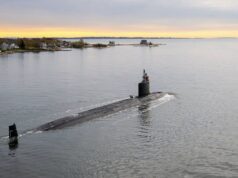
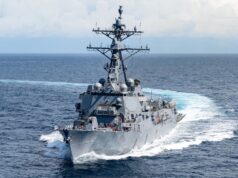
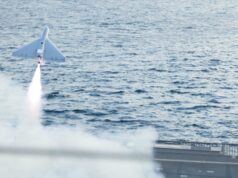

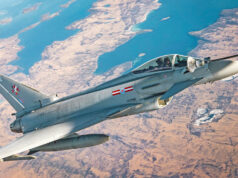
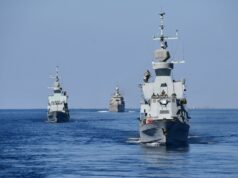
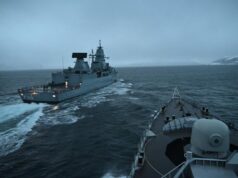
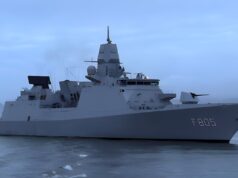
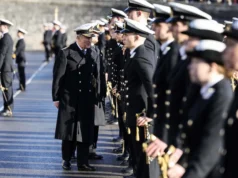
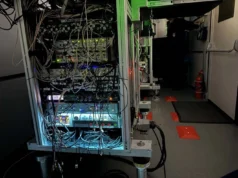

B e a utiful
Defiantly a good looking ship. Loving the good lines.
All that ugly equipment will ruin her looks?
1 down, 4 t’go!
And one of these will replace HMS Clyde soon
That was quick!
Wish they had put a proper gun up front but she looks the part ?
Just wish that BAE Systems had charged a discount price to the UK Taxpayer and built them in Portsmouth whilst the Clyde started in the Type 26/31
They are a private company. That’s wilful thinking.
I’d recommend reading the article on OPV capability and cost published by Think Defence. Brazil bought BAE OPVs at £155m whilst the RN version of the same design was priced at £348m. There are differences but the price differential does raise questions. A look at Hansard reports of the Parliamentary Defence Committee will give more detail and show how MPs are also questioning whether this British Company provide value for money. With only the two Scottish yards capable of building warships the UK has some serious issues to face up to. I may be guilty of some wishful thinking but I am certainly not alone in raising this issue.
The Brazilian vessels were originally ordered by Trinidad and Tobago for their coastguard. When they cancelled the order, they had to pay a cancellation fee and so the Brazilians were able to pick them up at a discounted price.
Its a nice looking ship to be honest
Is it for fishing?
Billy Mason
Frankie Hayward
The Fifth would make a good counter piracy ship permanently stationed out in Bahrain. Quicker than the RFAs and Mine Hunters and armed with a 30mm, ideal for pirate dhows and not to mention the flight deck.
Did they forget her guns?
Hi Philip, the vessel has not been fitted out yet.
??
Maybe another 5/6 would be beneficial! With a bigger and better range of armaments! 2 for the Falklands 2 for the Bahrain 2 for Gibraltar and 4 in the UK! Just for starters!
There will be another four.
UK Defence Journal I meant on top of the other 4! The RN has been depleted of ships and manpower for fare too long! About time to spend a little more! Whilst I was serving I saw the steady decline and it’s got worse over the last 10 years!
I was in the Navy 1975 to 1984, and considering we had 26 frigates of one class at that time, it’s a crying shame how the Navy has ‘shrunk’ to it’s current size. It’s okay to say we will be building more, including the two new Carriers, but where is the manpower going to come from? At least it’s a start, and we are building more. Security of our shores is very important nowadays.
I totally agree. We need to drastically increase the number of quality ships, helicopters, planes and equipment that is available to our Navy.
i think manning will be a issue. arent they struggling now. the Aussie way of having two-three crews per would be the way to go to keep them at sea
Better pay and pension would be an idea! And more incentive for civvies to join!
Nice looking ship but really should have a little more bang for the buck, main gun is too small and should at least have a MANPAD missile system fixed to the deck like seastreak or the new multi role missle system but I’m sure there are provisions for this at a later date, they also should have been built in portsmouth or cowes to free up the clyde for the type 26
That’s a great looking vessel. Good to see the deck is large enough for Merlin allowing for expanded ops.
And built with British steel, or Welsh steel to be percise.
If they had equipped these with small number of sea ceptor, for example a quad pack, plus a radar interlink with other RN vessels, they would become insanely more powerful for any war situation.
Having these providing some basic, last ditch, coverage for support vessels, allowing the destroyers/frigates to operate further away covering say the landing craft or the carriers.
As it stands, they are pretty much useless in a fighting match unless its something with very light arms.
looks like the design team put all the effort into the front half and forgot about the rear. pity they didnt put a hanger on and put a wildcat on her. a similar style to the rnzn protector class would be better
We even out source fecking tug boats to the Dutch as we don’t have enough of them either.
Look at the size of our island and the area needing protected with continuous observation.
I honestly don’t know how the government can tackle how to maintain our NHS and grow our armed forces.
As I’ve mentioned before I think we should ask the US for military aid. Isreal will receive somewhere between 15 to 20 billion within the next ten years and I didn’t see them in Afghanistan, Iraq supporting US troops.
Our whole armed forces is just about integrated with the US and ut makes sense.
I just wish we had a leader with cajones.
Lets also stop aid to N Korea, India and Pakistan.
I’ve been an advocate of leasing vessels from the Americans for a while now. The Arleigh Burke class is a good ship, we could have saved costs with leasing a couple of carriers, already proven, including the aircraft. More money to spend on providing crew, and ships like HMS Forth.
Keep em comin, we need about another 15…
Why?
With a hanger or something similar, they could be used for anti-piracy protection, and potentially pay for themselves by leasing out protection to container ships, but without they are pretty much tied up flag flying close to safe shores. They can provide some basic fishery protection, but you don’t need a warship for that, any boat with armed guards would do the job.
If we ever needed to protect anything ,they would be useless as they are too under armed.
15 of them would cause even more man power issues, at a time where we don’t seem to have enough sailors to man all the war ships we have.
Chris Davies you seen this?
Waste of money. These serve no purpose apart from a government make-work scheme.
They do serve a purpose. One will be needed at the Falklands when HMS Clyde is retired, another could be deployed to somewhere like the Caribbean to tackle drug smuggling, whilst take the pressure off of the surface fleet, and the others will do things such as fishery protection and EEZ patrol.
Toby Parr you can’t argue with an arm chair expert mate so I’d not waste your breath ?
The existing river class can do those tasks you mention. The lack of hangar means it’s unlikely to be useful in the Caribbean due to it not being able to carry an embarked helicopter during hurricane season and has no servicing capability for long term helicopter deployment. The RN has some serious manpower challenges that are not going away any time soon, so filling a load of fishing boats with RN personnel means less are available for proper platforms that are useful.
You also forget that the only reason we are building them is because we have to pay to keep the ship yard busy. Make no mistake; if we didn’t have to, we would not be building these vessels.
‘HMS Forth will be submerged this week.’
I think you mean the barge it is on will be submerged, unless you know something we don’t?
Shame they ain’t got anyone to man it
What about HMS First, Second and Third?
Any idea of launch date/time?
I know it’s only a small ship but why in this day and age do we still have ships without cwis etc?? Sure one would make the world of defence in a air or missile attack instead of pot luck with hand held mini guns and gpmgs.
Because it’s a coastal patrol vessel not a huge Destroyer or Frigate
That one of my worries in war all ship are targets and these will be used all over the place eg the gulf
Christopher Kent better to have that protection then not. Look at the Syrians taking down helicopters with anti tank missiles ?
CIWS are expensive and need extra crew to operate and maintain. A pair of Phalanx would cost over £10m, maybe even as much as £15m, and even then might not protect against missiles. A concern with gun-based CIWS is that even if the missile is hit and disabled it will still have enough kinetic energy to do damage to the target. On a bigger ship it could probably absorb that damage, on a River it would probably totally disable it and maybe even sink it. For aircraft/helo threats there is space to embark marines so MANPADS are a possibility even now but overall it’s best to realise these OPVs shouldn’t be going into high threat areas even if they had CIWS.
How long do we have to wait for them to re-branded by the MOD as Type 31 replacements ?
Should have been built here in Portsmouth. We have the capacity and a huge ship building hall staying empty. A great shame!
Considering our frigates don’t have CIWS, I assume for cost reasons, then i don’t think there is much hope of them making their way to the river class.
We have just ordered a bunch of Phalanx CIWS by the way, not for the Rivers as you rightly say but for the carriers (unsurprisingly) and also the Tide class tankers that will be getting them. We do do quite a good job of putting CIWS on RFA vessels which is as it should be. Also, our frigates will be getting CIWS eventually, at least when they turn into T26s since that will have twin Phalanx I believe.
The interesting one to watch will be T31 to see if that gets decent CIWS. I would really hope so because there’s already concern about how dumbed down T31 might be vs T26 (terms like “glorified OPV” being thrown about) and lack of CIWS on T31 would be a very bad sign in my opinion.
How about transferring the Batch 1 ships to Border Force. They would really beef up their capabilities as recent reports say the agency is short of vessels. NO navy crewing either…releasing R.N. personnel for the new ships?
Longer term, could we not move to an small ‘fleet’ of vessels serving border force, coastguard, maritime agency and taking on fishery protection etc. As they would all operate in home waters there would be no need for regular R.N. crewing. In fact, it may become a career move for people leaving the forces.
Not sure it makes financial sense. I’ve read that a brand new Border Force 42m cutter costs £5m and has a crew complement of 12. The batch 1 Rivers have a complement of 30 and even dropping off any weapons manning and reductions elsewhere I can’t imagine the complement dropping below 20 and it’s probably more, and then there’s the extra fuel and maintenance costs of an older 80m vs a new 42m vessel.
If we could sell the batch 1s (plus Clyde) for even £7.5m each that would be £30m which would buy 6 cutters and need 72 crew from border force vs probably 85 crew to very lean-man three River 1s plus Clyde. I suspect my numbers might even be conservative in terms of selling on the Rivers and optimistic re lean-manning them so it might even be a case of Border Force getting 4 Rivers vs being able to afford to buy and crew more like 8 extra 42m cutters.
Good article , I loved the analysis – Does someone know where my assistant would be able to get ahold of a sample CBP 7533 form to work with ?
Must be good . It’s a Forth.